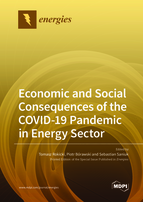Economic and Social Consequences of the COVID-19 Pandemic in Energy Sector
A special issue of Energies (ISSN 1996-1073). This special issue belongs to the section "C: Energy Economics and Policy".
Deadline for manuscript submissions: closed (30 September 2022) | Viewed by 41151
Special Issue Editors
Interests: energy economy; micro- and macro-economy; economic geography; logistics (above all transport problems); management of information
Special Issues, Collections and Topics in MDPI journals
Interests: agricultural economics; rural areas development; renewable energy sources; biomass production
Special Issues, Collections and Topics in MDPI journals
Interests: management science, production engineering, logistics, production management
Special Issues, Collections and Topics in MDPI journals
Special Issue Information
Dear Colleagues,
The Covid-19 pandemic has affected many sectors and areas of economic activity. One of them is the energy sector and the entire energy market. The specific economic and social effects of the Covid-19 pandemic are visible here. They can be observed and carefully assessed because the pandemic has been going on for over a year. The effects of a pandemic can be positive as well as negative. On the one hand, there have been changes in the energy enterprises themselves, including adaptation to the needs of consumers. On the other hand, there are also changes in the energy market on the demand side. Models of consumption and distribution of energy have changed. It was related to, inter alia, with forced spending time at home or remote work. The nature of work in enterprises and trade has also changed. As a result, the energy balance has changed. All these changes could also affect energy prices and the methods of energy distribution. The new situation could also contribute to the faster development of works on alternative energy sources or the use of renewable energy. As a result of the pandemic, innovations were introduced in many industries, which also indirectly influenced the directions of changes in the energy market and in the energy sector. The attitude of the society towards energy issues has also changed. Under lockdown conditions, this resource has become crucial for people. In such difficult moments, the public appreciates the innovations and changes that need to be introduced with care for the natural environment, including saving energy resources. The aim of the Special Issue is to collect the results of research and experience on the consequences of the Covid-19 pandemic visible after a year on the broadly understood energy sector and the energy market.
Dr. Tomasz Rokicki
Dr. Piotr Bórawski
Dr. Sebastian Saniuk
Guest Editors
Manuscript Submission Information
Manuscripts should be submitted online at www.mdpi.com by registering and logging in to this website. Once you are registered, click here to go to the submission form. Manuscripts can be submitted until the deadline. All submissions that pass pre-check are peer-reviewed. Accepted papers will be published continuously in the journal (as soon as accepted) and will be listed together on the special issue website. Research articles, review articles as well as short communications are invited. For planned papers, a title and short abstract (about 100 words) can be sent to the Editorial Office for announcement on this website.
Submitted manuscripts should not have been published previously, nor be under consideration for publication elsewhere (except conference proceedings papers). All manuscripts are thoroughly refereed through a single-blind peer-review process. A guide for authors and other relevant information for submission of manuscripts is available on the Instructions for Authors page. Energies is an international peer-reviewed open access semimonthly journal published by MDPI.
Please visit the Instructions for Authors page before submitting a manuscript. The Article Processing Charge (APC) for publication in this open access journal is 2600 CHF (Swiss Francs). Submitted papers should be well formatted and use good English. Authors may use MDPI's English editing service prior to publication or during author revisions.
Keywords
- changes in the energy sector as a result of Covid-19
- the energy market during the pandemic
- changes in energy balance as a result of Covid-19
- retail and wholesale energy prices during the pandemic
- adaptation measures in the energy sector during a pandemic
- energy consumption in the private and public sectors as a result of Covid-19
- energy consumption by individual consumers and businesses during a pandemic
- innovation in the energy sector and the energy market in a pandemic
- innovation in other sectors in the Covid-19 pandemic affecting energy consumption
- renewable energy during a pandemic
- alternative energy sources during a pandemic
- shifting energy-related ecological and environmental patterns as a result of Covid-19
- projected social consequences of Covid-19 on the energy market and the energy sector








